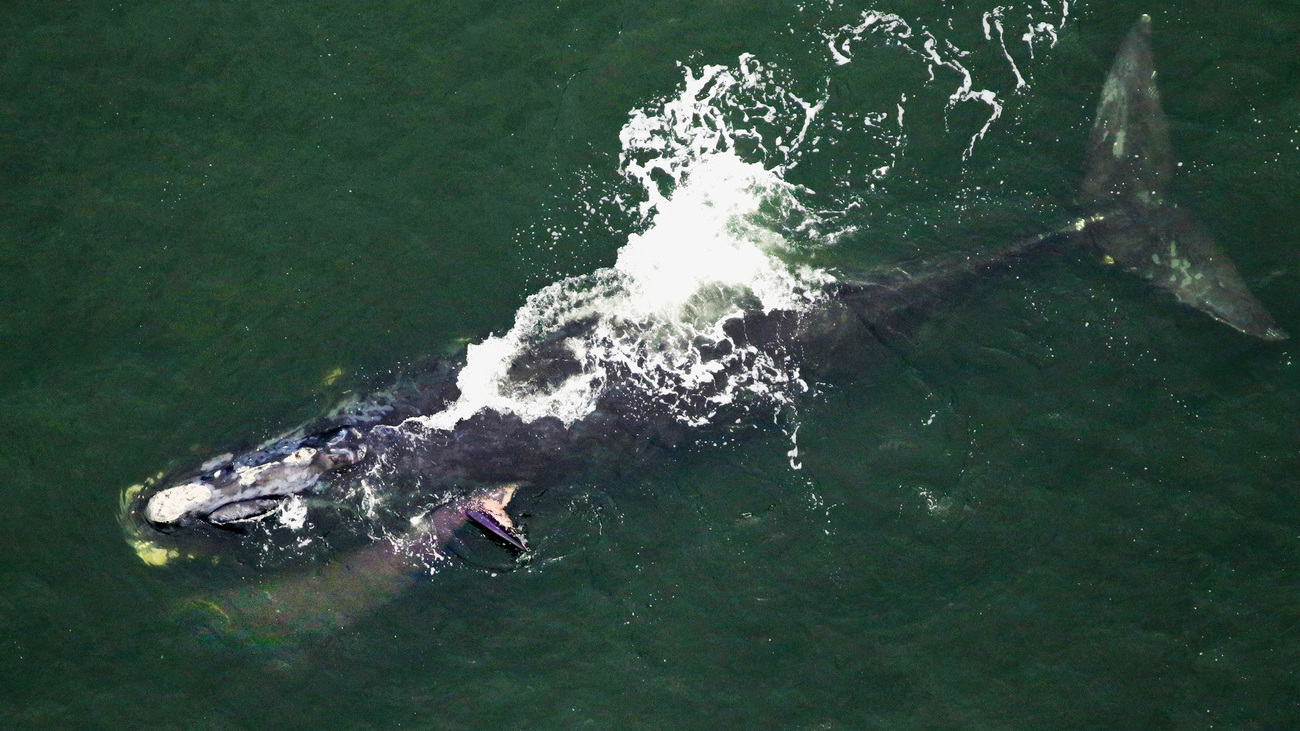Kathleen Collins
North Atlantic right whale calving season has begun: IFAW’s hopes and anticipations
North Atlantic right whale calving season has begun: IFAW’s hopes and anticipations
With a population of just around 370, North Atlantic right whales sit on the precipice of extinction. Every day, vessel strikes, entanglements in fishing gear, and climate change continue to threaten the lives of these endangered marine mammals. Since 2017, over 35% of right whales have been injured or killed, in what has been declared an Unusual Mortality Event (UME). The situation can only be described as dire.

But each year, calving season brings a little bit of much-needed hope. From mid-November through the spring, the species welcomes new calves to their dwindling numbers. With only 70 reproductive female North Atlantic right whales remaining, IFAW and our partners keep a close eye on their movements and activity, tracking and monitoring mothers and their calves as they are born.
Given the species’ high mortality and injury rates, the birth of 20 new calves this season would be considered a relatively productive year for North Atlantic right whales. However, to grow their population, they would need at least 50. Last year, we just reached the threshold of 20 new calves, but sadly five have died or are presumed dead.
This year, I am hopeful that we will have another successful season with 20 calves, and I am optimistic that the majority of those calves will survive and make it up north to the species’ feeding grounds. But their journey will not be easy.
Staying out of harm’s way
One of the most pressing threats to North Atlantic right whales is being struck by ships and smaller boats. Vessel strikes can easily injure or kill these whales, who often swim just below the water’s surface, making them difficult for mariners to spot.

Since the UME was declared in 2017, vessel strikes have caused 15 deaths, three serious injuries, and seven sublethal injuries. With such a small population of North Atlantic right whales remaining, these mortalities and injuries account for a large share of the whales we are counting on to save this species.
Last year, on 3 January, the first right whale calf of the season was spotted with several propeller wounds on its head, mouth, and lip, consistent with typical vessel strike injuries.
This year, we are particularly concerned about the risk of vessel strikes occurring in the calving grounds, where whales are most vulnerable and vessel speed restrictions remain unregulated.
IFAW has been working to mitigate vessel strikes by advocating for slower vessel speeds. There are rules in place mandating that vessels 65 feet and larger must follow a 10-knot speed rule in designated areas during times of high right whale occurrence. For vessels under 65 feet, the 10-knot speed zone is voluntary rather than mandatory. But in the calving grounds off the southeastern US coast, compliance with and enforcement of vessel speed regulations remain very low—especially within voluntary slow zones.
In addition to slowing down to prevent vessel strikes, there are ways to reduce the risk of whales becoming injured due to entanglements in fishing gear. IFAW is proud of the work our partners in the fishing industry have done in the US and Canada to remove vertical lines from the water during peak congregation season. However, more needs to be done to protect North Atlantic right whales and their calves, which become vulnerable to these threats the moment they are born.
Where will we see new calves this year?
Right whale calving grounds are typically off the southeastern US coast. So far, we’ve seen a calf with its mother off Cape Romain, South Carolina; another pair near Sapelo Island, Georgia; a third off Amelia Island, Florida; and a fourth near Virginia.
After they are finished calving in more southern waters, these whales travel northward to their feeding grounds, off the northeastern US and Canada. During calving season, a smaller number of right whales do remain around the northeast, including near Cape Cod and Nantucket, Hudson Canyon, and the mouth of Chesapeake Bay.

Here at IFAW, we’re eagerly watching and waiting for the rest of this year’s calves to make their grand appearances—while doing everything we can to protect them. We’re working at the federal, state, and local levels to prevent entanglements and vessel strikes, to give these newborns (and their entire species) the best chance of survival. Ultimately, swift human action is their only hope.
Related content
Every problem has a solution, every solution needs support.
The problems we face are urgent, complicated, and resistant to change. Real solutions demand creativity, hard work and involvement from people like you.